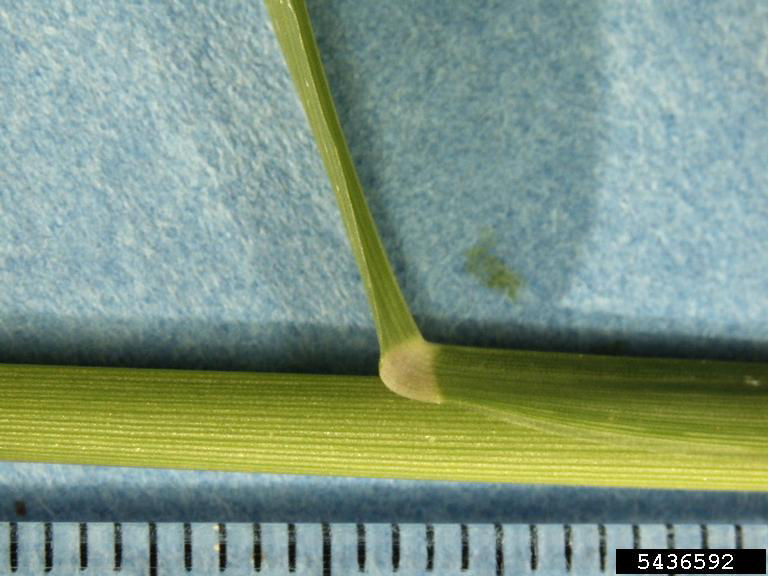Identification and Control of Barnyardgrass
January 31, 2024
Identification
Barnyardgrass (Echinochola curs-gali) is a warm-season, annual, grass species native to the Eurasian continent. It is unknown when the grass arrived in North America, but it now occurs across the continental United States and southern Canada.1 Barnyardgrass can be found anywhere; however, it prefers wet and saturated areas.
The grass is characterized by its wide, upright green leaves that transition to a purple-red-brown near the base and a pronounced white midrib. It is unique because it doesn’t have an auricle or ligule, only a thickened horseshoe shape at the base of blade just above the leaf collar (Figure 1). In early growth stages, barnyardgrass may have a more prostrate appearance and becomes more upright toward maturity. As a seedling, it may be difficult to differentiate from other species such as fall panicum which has a hairy ligule and pubescence on the underside of leaves.2 Under favorable growing conditions, barnyardgrass can reach heights up to five feet.

In northern climates, seed is produced from July through September. Barnyardgrass produces a densely seeded panicle with small reddish spikelets (Figure 2). These spikelets predominately contain an awn, but in some cases are awnless. Individual plants can produce tens of thousands seeds per plant depending on competition.1 Seed viability is greatly reduced after a single year; therefore, a single season of good control goes a long way toward a weed-free environment.

Control
Currently, in the upper Midwest there are no known herbicide resistance species within corn and soybean systems; however, in rice production systems there are biotypes that are resistant to eight different herbicide groups.3
Cultural control of barnyardgrass in row crop systems can be achieved by improving field drainage which can help enhance row crop establishment leading to an earlier canopy for shading. In soybean, narrow rows can help reduce weed seed germination by developing a quicker canopy compared to wider rows.
Chemical controls of barnyardgrass in row crop systems are plentiful. In soybean, residual herbicides such as Group 3 (Seedling Root Growth Inhibitors), Group 13 (Pigment Inhibitors) or Group 15 (Seedling Shoot Inhibitors) can be effective. Post-emergent options include Group 1 (ACCase inhibitors) or in the case of herbicide tolerant soybeans, Group 9 (Glyphosate) and Group 10 (Glufosinate).4 Group 3, Group 5 (Photosystem II Inhibitors) or Group 15 are all effective in control. Post application of Group 9 and 10 in tolerant crops or Group 27 (HPPD Inhibitors) can clean up infested fields.
James Jordan
Channel Agronomist
Sources:
1Mohler, C., DiTommaso, A., Teasdale, J. Barnyardgrass. Weed Profiles. Weed Science. Cornell College of Agriculture and Life Sciences. https://cals.cornell.edu/weed-science/weed-profiles/.
2Barnyardgrass. Weed Id Guide. 2020. University of Missouri. https://weedid.missouri.edu.
3Hartzler, B. and Anderson, M. Barnyardgrass. Integrated Crop Management. ICM News. Iowa State University Extension. https://crops.extension.iastate.edu/encyclopedia/barnyardgrass.
4Samuelson, S. and Bagavathiannan, M. Barnyardgrass. Grow: Getting Rid of Weeds Through Integrated Weed Management. https://growiwm.org/weeds/barnyardgrass/
Websites Verified 12/11/2023. 1110_349103
You may also like...
Here are some articles that may also be of interest to you